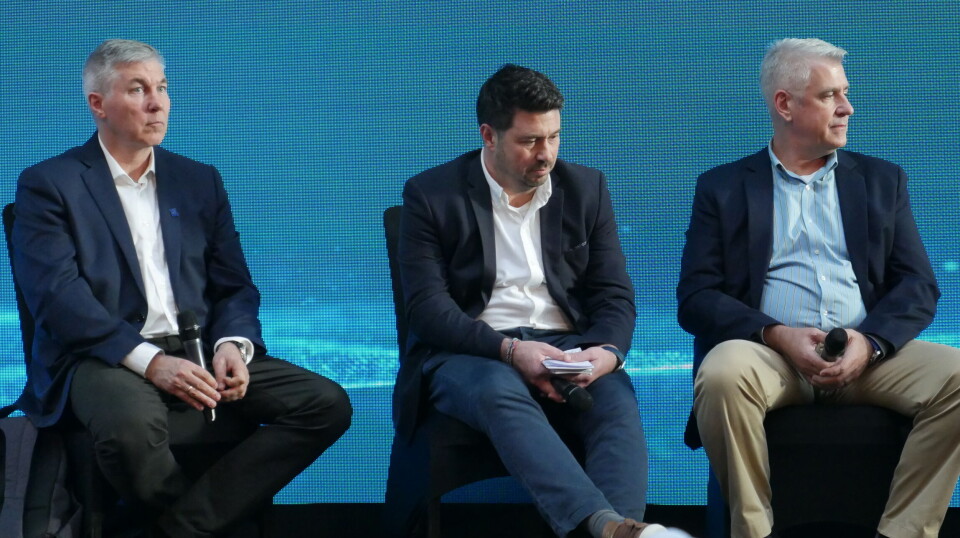
Successes fuel growing appetite for novel feed ingredients
Algal oil has now been included in 4m tonnes of BioMar feed and alternative protein options are adding to flexibility and choice, seafood summit is told
Novel aquafeed ingredients are delivering more than just good sustainability metrics. They are maintaining strong growth performance as well as showing positive effects on robustness, welfare and health, feed producer BioMar said this week.
Simon Wadsworth, the Danish company’s global research and development director, said that one such ingredient - algal oil – was now a well proven option for increasing the level of essential omega-3 fatty acids such as EPA and DHA in feeds. Omega-3 levels had dropped over the years due to replacement of a proportion of the marine ingredients with plant-based protein, but the recent provision of algal oils has allowed these key fatty acids to be supplemented in over four million tons of BioMar feeds.
This has made an important contribution to aiding key physiological and immune functions that are dependent on the supply of the EPA and DHA nutrients.
Single cell proteins
Wadsworth was speaking in a panel discussion about novel ingredients at the Global Seafood Alliance’s Responsible Seafood Summit at St Andrews, Scotland, on Wednesday.
Along with algal oil, he said single cell proteins offer great potential in terms of future volumes and raw material flexibility. Research undertaken by BioMar and leading research partners has shown that these proteins are performing very well for both growth and robustness in a range of aquaculture species.
“The novel ingredients also offer exciting synergies with existing raw materials. Single cell proteins incubated with soybean meals can reduce the presence of anti-nutrients as well as significantly increase overall protein levels,” said Wadsworth. “This technology opens other opportunities with a range of other existing, high-volume raw materials.”
The panel also featured Chris Haacke, commercial director for Scotland whisky-waste-to-omega-3 company Mi Algae; Lukas Manamaitis, aquaculture expert for the US Soybean Export Council (USSEC); Elin Kvamme, global aqua director at insect meal producer Innovafeed; Allan LeBlanc, aquaculture lead at single cell proteins producer Calysta; and Ian Carr, global business development director for algal oil producer Veramaris. The discussion was chaired by BioMar’s global marketing director Katherine Bryar.

The effects of feeding insect meals are now well documented for several species of aquatic animals. Results show strong growth performance at higher levels of inclusion as well as maintaining excellent robustness, welfare and health, most notably in shrimp. As insect meal production volumes increase these raw materials are being successfully deployed with customers in commercial operations.
Innovafeed’s Kvamme said: “The inclusion of insect meal can help shrimp better resist common bacterial infections like vibriosis and viral diseases such as white spot syndrome virus which is a significant concern in shrimp farming. The combination of antimicrobial peptides, chitin, and lauric acid in insect meals contributes to these health benefits by enhancing immune function, improving gut health, and providing anti-inflammatory effects.”
Take your choice
One novel ingredient that wasn’t represented by a member of the panel was crop-based EPA and DHA, grown in genetically modified varieties of plants such as canola and camelina.
“They have been very well researched over many years and show that EPA-DHA can be produced competitively and gives us another option,” said Wadsworth, who added that GM plants possibly offered options for segmentation in the market, between people who want a high marine content in feed, those who want omega-3 from algae, and those who simply want a cheap source of EPA and DHA.
“It offers us really good flexibility and options going forward.”
Safe and consistent
Asked by Bryar whether omega-3 from GM plants had any adverse effects on the health of fish, Wadsworth said: “None, there have been some very extensive studies on this. Genetic material is not taken into the oil or the end product so this is a very safe and consistent product going forward.”
USSEC’s Manamaitis said Europe probably had the biggest pushback against GM crops but added that globally billions of farmed animals and people eat GM food safely.
“People in Europe are going to have to talk a lot more about this fear of GM because the climate is changing and we are going to have to find a way of growing crops, because traditional genetics is not going to keep up.”

























































